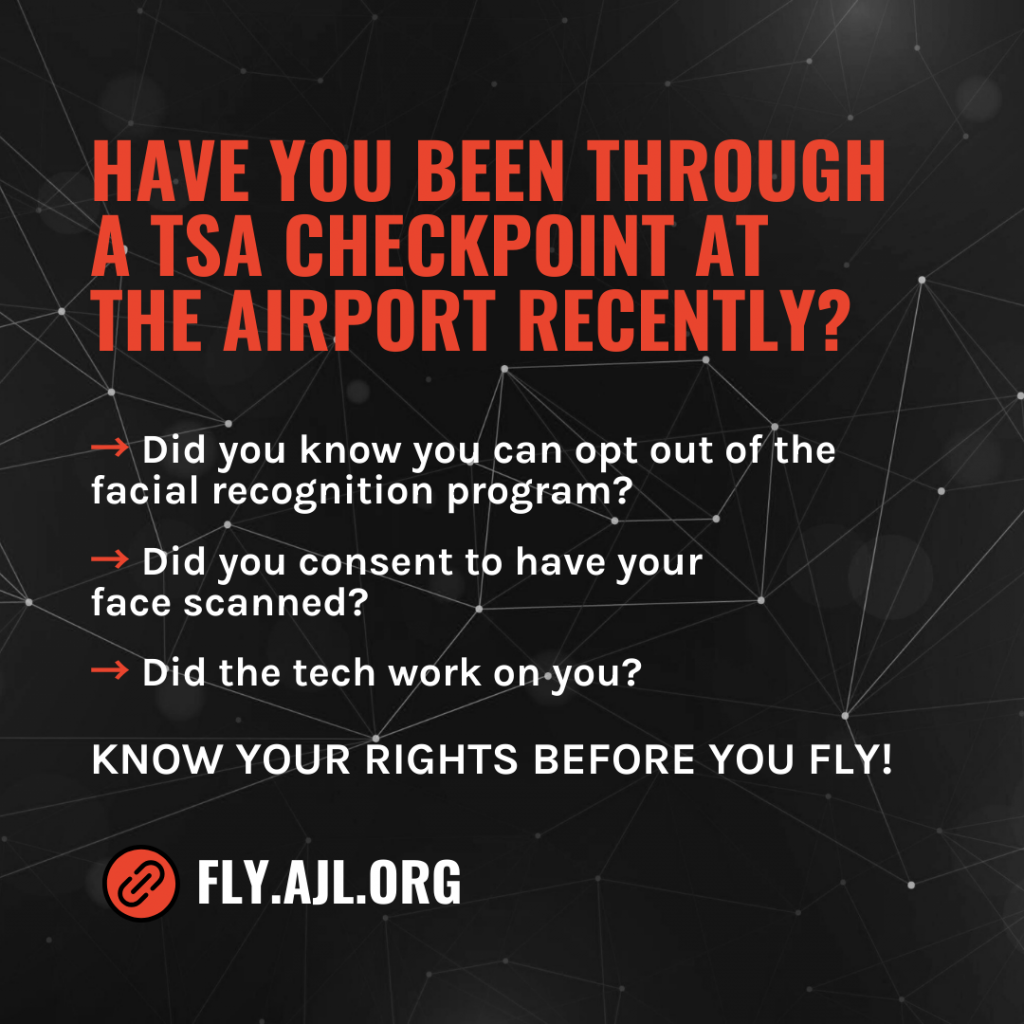Opting out of facial recognition at airports
Next week the Algorithmic Justice League will be launching an awareness and sousveillance campaign focused on the use of facial recognition in airports by the Transportation Security Administration (TSA) and its airport and airline partners.
The #freedomflyers campaign includes efforts to make travelers aware that the TSA claims that submitting to facial recognition is “optional”. The campaign also includes a free online Freedom Flyers Summit on “Resisting Airport Face Scans” on July 19th and — perhaps most importantly — a scorecard for travelers to report what actually happens when they try to opt out of facial recognition at airports.
In many cases, staff or contractors of airlines, airport operators, or the TSA tell travelers that facial recognition is required. In other cases, facial recognition turnstiles are unattended by any staff, leaving no apparent way to opt opt. Some facial recognition turnstiles are attended only by “line-minders” or security guards or subcontractors with no authority to allow travelers to pass through without submitting to mug shots.
Asking “Did the tech work?” is, of course, a trick question.
The purpose of facial recognition in airports is to enable tracking of travelers, without our being able to tell when, where, or by whom we are being tracked. If “Did it work?” means, “Did it enable those who want to track you to track you, without your knowledge?”, than by definition, if it “worked”, you won’t know.
You may know that your face was scanned once, perhaps when you entered the terminal or checked in or checked your luggage, but you may not know how many other times it was scanned, where, when, by whom, or for what purposes. The goal of public-private partnerships in airport surveillance is seamless multi-purpose data sharing and “curb to curb” traveler tracking through common-use embedded facial recognition infrastructure.
One thing you can do to mitigate the risk of hidden cameras is to wear a face mask in the airport, except when you are ordered to remove it by someone who has identified themselves as an authorized agent of the TSA and has told you that removing your mask is required as a condition of travel. If you have to remove your mask so that a human TSA agent can compare your face to the picture on your ID, make sure that you stand out of the line of of any visible cameras. If they try to point a camera at your face while you have your mask down, hold up your hand to block the camera and tell them you don’t consent to having your face photographed.
The TSA claims that removing your mask for a human check is required, but that being photographed is not. To date, no court has ruled on whether the TSA can require travelers to remove face masks or submit to mug shots or automated facial recognition. Nor has any court ruled on whether a common carrier could require removal of masks or submission to mug shots or automated facial recognition as a condition of carriage.
We welcome the AJL campaign to educate travelers about facial recognition in airports and to encourage them to opt out. Merely opting out won’t put an end to the practice, but it’s an important step. We look forward with interest to the responses to the AJL survey.

Pingback: More News and Opinion Not from Regime Media – Scott Lazarowitz's Blog
I declined facial recognition by tipping my brimmed ball cap down deep when I saw the cameras at LaGuardia and/or OHare in late May 2024, it was Memorial Day weekend. I peeked out and said to a person, I believe I can decline facial recognition, how do I do that? He just nodded and I went by the only one or two cameras (I noticed) in the security line with my brim down over my face and chin. That was it. I have no idea if “it worked” which for me would have been to BLOCK my face from scanning. I’m really glad you are doing this work! Reach out if you’d like me to figure out the details. I can go back and get flight dates, etc.
Pingback: Today's News: July 15, 2024 - The Power Hour
Pingback: Opting out of facial recognition at airports - The Power Hour
Recording of “Freedom Flyers Summit: Resisting Airport Face Scans”:
https://www.youtube.com/watch?v=3rU5CxYhLzs
Opt-out scripts and crib sheets:
https://keepbeyond.com/optout/